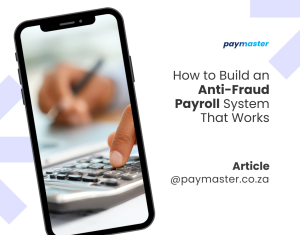Today, data helps businesses make decisions. If you work in HR, management, or finance, having correct and current information helps you plan well, act quickly, and lead with confidence. A smart choice is to keep all training records inside your payroll system.
Why? Because payroll systems already hold important employee details—like job titles, pay, departments, and start dates. That’s why putting training records in your payroll system—and using Employee Self-Service—is not just smart. It helps your whole business.
1. Training Costs Are Instantly Accessible
Knowing how much training costs helps you budget, check your return on investment, and plan for the future. However, if you keep training records separate from payroll, things get tricky. You have to combine data by hand, which wastes time, causes mistakes, and means you do the same work twice.
But when you store training records in your payroll system, things get much easier:
- First, you can quickly see training costs for each employee, department, or job role.
- Then, you can create reports that connect training spend to salary, time with the company, or promotions.
- You can also track any training reimbursements or financial help employees may get.
- Plus, you can add training costs to your monthly payroll reports to make financial tracking smooth.
Instead of hunting through spreadsheets or waiting for HR to gather data, you get everything you need in one place—just a few clicks away.

2. Simplifies Planning for Skills Development
Your organisation’s future depends on the skills you build today. Whether you follow a B-BBEE skills plan, get ready for staff changes, or meet legal rules, training plays a key role—and how you manage it matters just as much.
When you keep training records in your payroll system:
- HR and managers can easily look at past training to find skill gaps or trends
- You can quickly track when training needs to be renewed or certificates expire
- Planning your workforce gets simpler because you can link training to job roles, pay levels, and open positions
- You can create reports fast for audits, SETA, and employment equity plans
Good planning isn’t only about the future—it’s about having the right information right now to make smart choices.
3. Improves Access for Managers and Line Leaders
Managers play a very important role in helping employees grow. However, they are often the last to find out what training has been completed, what is overdue, or what is planned next. This happens because training information is usually kept on a different system or even on paper. As a result, managers cannot access it quickly. Also, HR has to spend extra time sending updates to them.
On the other hand, payroll systems are often already used by managers for tasks like approving leave, checking timesheets, or managing performance. Therefore, when training records are kept in the same system, many things improve:
- First, managers can check their team’s training records anytime they want.
- Next, they can easily see any skills that are missing and suggest the right training.
- Also, they can help plan who will take over important roles in the future.
- In addition, access can be controlled to keep information private but still give managers what they need.
- Finally, it becomes much easier to track important training like health and safety or required certifications.
Because of all this, the leadership team becomes more involved and better informed. As a result, they can support employee growth and make sure the business follows all the rules.

4. Empowers Employees Through Self-Service
One of the most exciting features of today’s payroll systems is Employee Self-Service (ESS). What’s even better is when training is included in ESS, because the benefits grow even more.
With ESS:
- First, employees can easily see available training courses and schedules right on their own dashboards.
- Then, they can check which training is planned, which is optional, and which is required.
- Also, employees can apply for specific training programs themselves, showing initiative and taking charge.
- Meanwhile, HR can send reminders about upcoming mandatory training, and employees can accept invitations or confirm they’ve completed the training.
- Finally, employees can track their own progress, including courses they’ve finished, certificates earned, and any training still needed.
Because of this, training stops being just a top-down task for management. Instead, it becomes a shared journey where employees feel informed, in control, and motivated. At the same time, HR and managers can keep an eye on progress and compliance.
In short, ESS isn’t just about payslips and leave anymore. It’s now about learning, growth, and communication—all in one easy place.
5. Reduces Administrative Burden
Let’s be honest: HR teams are very busy. Using separate systems for payroll, HR, and training creates extra work and can lead to mistakes. But when you put all your training records together with payroll, you get many benefits:
- First, you only enter data once—new employees are added automatically to training lists.
- Also, your data stays consistent, so there are no differences between systems.
- Plus, you spend less time looking for records because everything is stored safely in one place that’s easy to search.
- Finally, you use fewer outside systems, which means less manual work and fewer errors.
On top of that, with Employee Self-Service (ESS), employees take more control over their own training. This lets HR spend more time planning and helping people grow instead of chasing attendance or updating records.
6. Boosts Compliance and Audit Readiness
Whether you’re getting ready for a SETA inspection, an EE audit, or internal checks, you need clear and easy-to-check training records. Payroll systems help by:
- Keeping date-stamped records of all completed training
- Letting you quickly create reports ready for audits
- Storing all records securely in one central place
- Connecting training data with employment equity and B-BBEE documents
When you can show exactly how much you spent on training, prove who completed it, and link it to job roles and development plans, compliance becomes easier and even a business advantage.
7. Builds a Culture of Learning and Accountability
When you put training records in your payroll system and let employees use ESS to manage their learning, you make training a big part of your company.
Because of this:
- Everyone can see and appreciate training
- Training matches what employees want and what the company needs
- HR, managers, and employees all share the responsibility
Now, employees don’t wait for instructions. They log in, check their training schedule, sign up for courses, and track their progress—all in the same place where they see their payslips and update their info.
It’s easy. It gives employees control. And this is how smart companies work today.
Final Thoughts
Your payroll system does more than pay salaries. It stores all your important employee information. When you add training records and use Employee Self-Service, you create a system that helps your business grow, follow the rules, and keep employees engaged.
So, don’t keep training records separate. Put them in your payroll system and give your team the tools to improve.
If you need help setting this up, contact us at Paymaster Payroll. We will show you how to combine training records and development programs into one easy, safe, and powerful system—where every employee and manager can access their own information.





